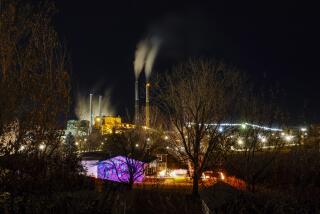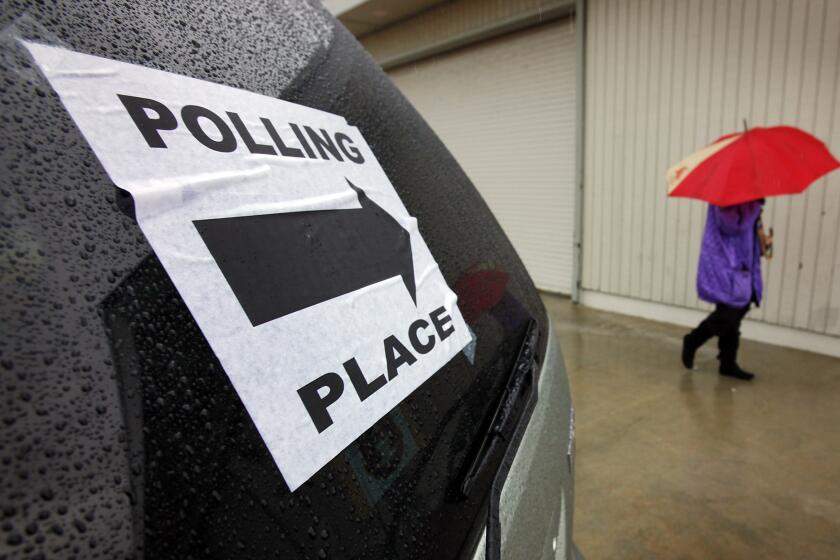Alaskans See Bright Side to Soaring Pump Prices
ANCHORAGE — Filling up his Ford Taurus at a Tesoro gasoline station and shelling out $2.869 a gallon for the privilege, Steve Ginnis expressed a common American ire these days -- but with a particularly Alaskan twist.
“We’ve got a dang oil pipeline running the length of the state,” said Ginnis, a regional housing authority director. “Alaska’s swimming in oil.... No way we should be paying three bucks a gallon. It’s ridiculous.”
But while Ginnis and other Alaskans are clearly irked by high prices at the pump, some also see an upside -- a very big upside.
“Alaska is an oil state,” said John Pearson, a pipe fitter filling up his Chevy Tahoe, his face creasing into a very slight smile. “No one likes high prices. But maybe high prices for oil are less bad for us than people ‘outside.’ ”
“Outside” is the standard term Alaskans use for any place, well, outside Alaska.
Inside the Last Frontier, where every man, woman and child received a dividend check last year for $854.76 from the state’s optimistically named “Permanent Fund” of oil-generated wealth, there is a sense that record-high oil prices might not be the worst thing that ever happened here.
In fact, legislators in Juneau, the state capital, say they are anticipating a windfall in the budget this year, leaving them with as much as $2.4 billion in unexpected revenue to spend on capital construction -- including the state’s share of two projects that critics describe as “bridges to nowhere” and which have become symbols of congressional pork-barrel spending run amok.
“While the rest of the country is squirming with high gas prices, we’re laughing all the way through the capital budget,” said Sue Libenson, an organizer with the Boreal Songbird Initiative, an environmental group critical of the bridge projects.
Alaska developers say the bridges are no laughing matter, but instead will be vital spurs to economic development, and they have persuaded state lawmakers to set aside more than $90 million for each project.
One bridge would cross over the waters of Knik Arm in Anchorage to a currently undeveloped stretch of peninsula nearby. The other would connect Ketchikan, a city of about 9,000 at the very southeastern tip of Alaska, to an island, population 50, where its airport is located. The two have been linked for years by a six-minute ferry ride.
After specific federal earmarks for the bridges received the Taxpayers for Common Sense “Golden Fleece Award” last year for wasteful spending, Alaska’s congressional delegation agreed to remove them -- but then quickly secured such a large pot of federal highway money for the state that design and other planning for the bridges went right on ahead.
Many in Alaska are confident that oil- and gas-fueled prosperity will continue indefinitely, sustaining a tax structure in which there aren’t a lot of taxes.
Alaskans pay no state income or sales taxes, for instance. Since the oil-fund payout plan was launched in 1982, residents have received more than $13.5 billion in such dividends.
If President Bush and congressional Republicans succeed in their long-running quest to open the Arctic National Wildlife Refuge to drilling, there could be a new bonanza in the state.
Meanwhile, planning continues for yet another mega-project: a pipeline to carry the estimated 35 trillion cubic feet of natural gas reserves on Alaska’s North Slope to markets on the West Coast and in the Midwest. Sustained high prices on the world market for gas could make the $25-billion pipeline more than feasible, many energy experts and Alaskan political figures say.
“Alaska does not just take,” Gov. Frank H. Murkowski, a Republican, said in his State of the State address this year, an allusion to the tiny congressional delegation’s remarkable -- and oft-criticized -- ability to secure huge federal spending.
“We give,” Murkowski said, referring to oil and other natural resources here, “and we have the capacity to give much, much more -- if permitted to do so.”
But some experts say that Alaska is way too addicted to oil money -- and that the spigot is slowing: About a million barrels of oil per day are coursing through the trans-Alaska pipeline, about half the peak rate in the 1980s, according to the state Division of Oil and Gas.
The continued growth in state spending “ought to scare the hell out of you,” Sen. Gary Wilken (R-Fairbanks), co-chairman of the state Senate Finance Committee, warned his colleagues earlier this session.
“We’re dancing on a pin,” said Wilken, referring to high prices for crude oil, “and we’re praying to the oil gods that we’re going to be living on it up here for years to come.”
More to Read
Sign up for Essential California
The most important California stories and recommendations in your inbox every morning.
You may occasionally receive promotional content from the Los Angeles Times.










